Gender pay gap report
Bath Spa University is committed to ensuring equal opportunities for all staff and is dedicated to addressing issues that cause barriers to equal opportunity for all employees.
As Bath Spa University’s newly appointed Vice-Chancellor, I welcome the opportunity to publish our Gender Pay Gap Report. It is an impor tant way of maintaining momentum and ensuring accountability within our institution. This year our Gender Pay Gap has increased to 9.7% from 7% in the previous year. We understand why this change has occurred and evidence this in the following report.
tant way of maintaining momentum and ensuring accountability within our institution. This year our Gender Pay Gap has increased to 9.7% from 7% in the previous year. We understand why this change has occurred and evidence this in the following report.
At our University we employ more staff that identify as female than male; this remains especially true at lower pay grades.
We also employ students, who mainly identify as female rather than male. This is part of the reason why our gender pay gap still remains. Being able to give students the opportunity to work part-time alongside their studies is important to us and data shows that students who engage in casual work have a higher chance of positive graduate outcomes.
However, we are pleased to also note that we have a significant number of female staff who are also employed in senior positions.
We recognise that we need to be doing more to tackle gender inequality at all levels within our University. This includes giving our staff development opportunities, promoting talented staff and ensuring that we do not discriminate.
We must continue to work with enthusiasm and continue to listen and support our staff to thrive and thus address gender inequality.
Although progress takes time, we are committed to producing permanent and positive change as demonstrated through our Equality Objectives and our ongoing equalities work mentioned in the report below.
Professor Georgina Andrews
Vice-Chancellor
Gender Pay Gap Report 2024 (Published in 2025)
By law, any organisation with 250 or more employees must publish information about their gender pay gap – the difference between the average (median and mean) earnings of all men and women working across the organisation.
The Gender Pay Gap is different from our Equal Pay Review, which compares the pay differences between men and women who carry out work of equal value and checks to see if there are any differences or inequalities.
The Equal Pay Review enables us to monitor the effectiveness of our pay framework and job evaluation processes that were put in place as part of our commitment to ensure equal pay for equal value.
We last undertook an Equal Pay Review in 2021 and the result of it is published on our staff Intranet (staff log in required).
How is it worked out?
The Gender Pay Gap Report is a measure of the difference in pay between the average hourly earnings of male and female staff.
The mean is calculated by summing the hourly rates of each employee and then dividing by the number of employees.
The median is the middle value when all hourly rates are ranked from smallest to largest.
In our case, pay gaps are primarily due to a higher proportion of women occupying more junior roles within the University, as well as the large number of women employed as casual staff, who are mainly Bath Spa University students. Our large number of women casual workers is representative of our student population.
What is Equal Pay vs. the Gender Pay Gap?
Equal pay means that men and women performing equal tasks in the same organisation receive equal pay for said tasks.
The Gender Pay Gap measures the difference between men’s and women’s average earnings and is expressed as a percentage of men’s earnings.
It is possible to have equal pay and yet still have a gender pay gap.
Gender Pay Gap and gender identity
As per the current requirements, gender pay gap reporting must be conducted in a binary way, recognising only men and women. This means that we are not able to consider non-binary or other gender identities in our formal reporting.
The language used in our report is binary, i.e. 'gender', 'man/male', 'woman/female' as per the requirements. However, we recognise that this is not an accurate reporting of our true staff data.
We currently have 13 members of staff reporting as non-binary or other gender identities, who are not accounted for in the government figures. This group is currently too low in number to produce any meaningful pay gap analysis, however we will continue to monitor this and when meaningful data is available, we intend to include it within this narrative.
We, as a university, continue to strive to create an inclusive environment, whereby everyone can recognise their talent and thrive, for their own benefit and for the wider good.

As of March 2024, 61.1% of our staff identified as female, which was an increase on the previous year. There has been a corresponding decrease in the percentage of staff identifying as male, to 38.9%.
The mean average Gender Pay Gap at Bath Spa University is 9.7% equivalent to £2.20 per hour. The median pay gap is 13.7% or £2.96 per hour.
Both figures have increased from last year where they were at 7.0% and 7.2% respectively
There are contributing factors to this change as listed below:
- There has been an overall increase in the percentage of female staff employed from 59.3% to 61.1%
- The majority of female staff joined at the lower grades, and this can be seen in the increase of the percentage of female staff employed in the Lower Middle and Lower Quartiles, particularly in the Lower Quartile where the percentage of female staff is now at 75%.
- There was a larger percentage increase in the number of male staff employed in the Upper Quartile, than there was of female staff. In terms of the Lower Quartile the proportion of male staff decreased by 6% whereas there was an increase in the proportion of female staff by 34%.

Pay by quartiles shows the distribution of staff based on their hourly pay. We can see from this that our Gender Pay Gap is due to the greater increase of women in lower-paid roles, especially in the Lower Quartile, where there are 3x as many women as men (75.2% female vs 24.8% male). In 2023 the Upper Quartile consisted of 51.9% female, and this has slightly increased again to 52.6% of staff who identify as female in 2024.
Casual Workers
Bath Spa University defines casual workers as workers who are engaged for the University on a ‘casual’ basis. These would include, for example, student ambassadors, student events staff or student catering staff.
-500x729.jpg)
.jpg)
Casual workers
In 2024 we had 240 casual workers, showing an increase of 36% in the number of casual workers, up from 177 in the previous year. Of these 78% were female and 22% were male which is a further increase in the number of female staff from the previous year.
As of March 2024, from our total number of students: 67.1% identify as female, 32.9% as male and 0.3% as other/nonbinary.
This remains a similar trend from previous years, as we tend to have more female students in casual worker roles.
Being able to give students the opportunity to work part-time alongside their studies is important to us and data shows that students who engage in casual work have a higher chance of positive graduate outcomes.
Therefore, despite casual workers leading to an increase in the pay gap, these opportunities are important to our students and to us.
Our data as of March 2024, excluding casual workers
Keeping the casual worker data in mind, we have also calculated our Gender Pay Gap data, without casual workers, which tells a different story.
In 2024 our Mean Pay Gap, excluding casual workers, has increased to 4.6%, however our Median Pay Gap, excluding casual workers had decreased to 4.1%.
For 2023 our Mean Pay Gap, excluding casual workers had decreased to 3.5% and our Median Pay Gap has decreased to 5.6%.
The reason for this disparity lies in the split between the earnings of men vs. women in the top and bottom quartiles.
The mean gap has risen because the proportionate growth of men at higher grades and the corresponding decline of men in the lower grades has increased the difference between average male and female pay. The median gap has shrunk because the number of casuals that we have employed has increased in addition to the proportion of female staff.

Ideally, to completely close the gap each Quartile would be representative of our staff body as a whole. Therefore, in this year's case, each quartile would ideally have 42.1% male and 57.9% female staff.
We can see by looking closely at each quartile that most of our female staff are in lower-paid jobs, though the number of male staff rises as we go up in the quartiles. This, with and without casuals is where the pay gap arises.
Reducing our gender pay gap

Reducing our Gender Pay Gap
Though the results for our gender pay gap are not as promising as we would have hoped - we remain committed to continuing our work, to reduce the pay gap at Bath Spa University.
Alongside the reasons explained above, we have in place several measures that aim to reduce our gender pay gap in the future, including:
- Our Equality Objectives and action plans which include a focus on mitigating against bias in the staff recruitment process, support for staff equality networks development, and continuing to develop an inclusive Bath Spa culture.
- Mandatory Diversity and Unconscious Bias training.
- Monitoring of staff experience and well-being through regular Staff Surveys.
- Continued development of the Women’s Staff Network, including multiple meetings throughout the year and marking International Women’s Day.
- Membership and engagement of a new Higher Education networking platform for people who identify as women and non-binary called ‘WHEN’.
- Leadership training programmes seuch as Elevate and Aurora.
- Creating and publishing a menopause policy.
- Changing our Maternity and Paternity policies to Pregnancy and Partner policies to ensure they are gender neutral.
- Continued development and delivery of the sexual violence framework.
- Obtaining a RE:SET Accreditation - after working jointly with the Students' Union over the last 18 months, we have been awarded the Tender RE:SET Universities Award for 3 years. The Award means that the University and Students' Union have successfully demonstrated that we have in place effective awareness and prevention campaigns, support and external relationships around gender-based violence and domestic abuse. The Award also recognises that we have developed a positive campus culture so that staff and students feel safer to report issues, and staff are better equipped to appropriately support and direct disclosures to the available internal and external support.
- In addition to the Women’s Staff Network we have continued to support the:
- Equalities network
- Disabled Staff Network
- Neurodivergent Staff Network
- LGBT+ Staff Network
- Global Inclusivity Staff Network
- Mental Health First Aiders network
- Parents and Carer’s network.
We recognise the importance of intersectionality and the fact that pay gaps may be exacerbated for staff who are also in these groups.
Previous Gender Pay Gap reports
Previous years' reports are available on the staff intranet (staff login required).

As of March 2024, 61.1% of our staff identified as female, which was an increase on the previous year. There has been a corresponding decrease in the percentage of staff identifying as male, to 38.9%.
The mean average Gender Pay Gap at Bath Spa University is 9.7% equivalent to £2.20 per hour. The median pay gap is 13.7% or £2.96 per hour.
Both figures have increased from last year where they were at 7.0% and 7.2% respectively
There are contributing factors to this change as listed below:
- There has been an overall increase in the percentage of female staff employed from 59.3% to 61.1%
- The majority of female staff joined at the lower grades, and this can be seen in the increase of the percentage of female staff employed in the Lower Middle and Lower Quartiles, particularly in the Lower Quartile where the percentage of female staff is now at 75%.
- There was a larger percentage increase in the number of male staff employed in the Upper Quartile, than there was of female staff. In terms of the Lower Quartile the proportion of male staff decreased by 6% whereas there was an increase in the proportion of female staff by 34%.

Pay by quartiles shows the distribution of staff based on their hourly pay. We can see from this that our Gender Pay Gap is due to the greater increase of women in lower-paid roles, especially in the Lower Quartile, where there are 3x as many women as men (75.2% female vs 24.8% male). In 2023 the Upper Quartile consisted of 51.9% female, and this has slightly increased again to 52.6% of staff who identify as female in 2024.
Casual Workers
Bath Spa University defines casual workers as workers who are engaged for the University on a ‘casual’ basis. These would include, for example, student ambassadors, student events staff or student catering staff.
-300x437.jpg)
-300x259.jpg)
Casual workers
In 2024 we had 240 casual workers, showing an increase of 36% in the number of casual workers, up from 177 in the previous year. Of these 78% were female and 22% were male which is a further increase in the number of female staff from the previous year.
As of March 2024, from our total number of students: 67.1% identify as female, 32.9% as male and 0.3% as other/nonbinary.
This remains a similar trend from previous years, as we tend to have more female students in casual worker roles.
Being able to give students the opportunity to work part-time alongside their studies is important to us and data shows that students who engage in casual work have a higher chance of positive graduate outcomes.
Therefore, despite casual workers leading to an increase in the pay gap, these opportunities are important to our students and to us.
Our data as of March 2024, excluding casual workers
Keeping the casual worker data in mind, we have also calculated our Gender Pay Gap data, without casual workers, which tells a different story.
In 2024 our Mean Pay Gap, excluding casual workers, has increased to 4.6%, however our Median Pay Gap, excluding casual workers had decreased to 4.1%.
For 2023 our Mean Pay Gap, excluding casual workers had decreased to 3.5% and our Median Pay Gap has decreased to 5.6%.
The reason for this disparity lies in the split between the earnings of men vs. women in the top and bottom quartiles.
The mean gap has risen because the proportionate growth of men at higher grades and the corresponding decline of men in the lower grades has increased the difference between average male and female pay. The median gap has shrunk because the number of casuals that we have employed has increased in addition to the proportion of female staff.

Ideally, to completely close the gap each Quartile would be representative of our staff body as a whole. Therefore, in this year's case, each quartile would ideally have 42.1% male and 57.9% female staff.
We can see by looking closely at each quartile that most of our female staff are in lower-paid jobs, though the number of male staff rises as we go up in the quartiles. This, with and without casuals is where the pay gap arises.
Reducing our gender pay gap

Reducing our Gender Pay Gap
Though the results for our gender pay gap are not as promising as we would have hoped - we remain committed to continuing our work, to reduce the pay gap at Bath Spa University.
Alongside the reasons explained above, we have in place several measures that aim to reduce our gender pay gap in the future, including:
- Our Equality Objectives and action plans which include a focus on mitigating against bias in the staff recruitment process, support for staff equality networks development, and continuing to develop an inclusive Bath Spa culture.
- Mandatory Diversity and Unconscious Bias training.
- Monitoring of staff experience and well-being through regular Staff Surveys.
- Continued development of the Women’s Staff Network, including multiple meetings throughout the year and marking International Women’s Day.
- Membership and engagement of a new Higher Education networking platform for people who identify as women and non-binary called ‘WHEN’.
- Leadership training programmes seuch as Elevate and Aurora.
- Creating and publishing a menopause policy.
- Changing our Maternity and Paternity policies to Pregnancy and Partner policies to ensure they are gender neutral.
- Continued development and delivery of the sexual violence framework.
- Obtaining a RE:SET Accreditation - after working jointly with the Students' Union over the last 18 months, we have been awarded the Tender RE:SET Universities Award for 3 years. The Award means that the University and Students' Union have successfully demonstrated that we have in place effective awareness and prevention campaigns, support and external relationships around gender-based violence and domestic abuse. The Award also recognises that we have developed a positive campus culture so that staff and students feel safer to report issues, and staff are better equipped to appropriately support and direct disclosures to the available internal and external support.
- In addition to the Women’s Staff Network we have continued to support the:
- Equalities network
- Disabled Staff Network
- Neurodivergent Staff Network
- LGBT+ Staff Network
- Global Inclusivity (BAME) Staff Network
- Mental Health First Aiders network
- Newly created Parents and Carer’s network.
We recognise the importance of intersectionality and the fact that pay gaps may be exacerbated for staff who are also in these groups.
-01-500x602.png)
As of March 2022, 60.9% of our staff identified as women, and 39.1% as men. The mean average gender pay gap at Bath Spa University is 11%, equivalent to £2.24 per hour. The median pay gap is 11% or £2.22 per hour. In 2021 these figures were 9.8% and 11.1% respectively, showing an increase in the gender pay gap. For the mean calculation, this is a small percentage increase from the previous year. This is primarily because of the increased number of casual workers (described further below), who predominantly identify as female, further evidence of this is shown below where we present our gender pay gap excluding casual workers.
-02-500x288.png)
Pay by quartiles shows the distribution of staff based on their hourly pay. We can see from this that our Gender Pay Gap is largely due to higher proportions of women in lower-paid roles, especially in the lower quartile, in which there are twice as many women as men. Last year our Upper Quartile consisted of 50.2%, this has increased again to 51.1%.
-04-500x384.png)
The total number of Bonus Pay was awarded to 0.72% of our staff which equates to 9 staff members. When split by gender, bonuses were paid to 0.92% of women which represents 7 staff and 0.41% of men which represents 2 staff. The mean bonus pay gap is 62.1%, and the median is 83.4%.
These bonuses consisted of long service rewards, where after working for the University for 20, 30 and 40 years, or retiring after 20 years of service, staff will receive a choice of cash or vouchers, which increases every 10 years. Bonuses also consisted of profit shares, where staff are being paid under our profit sharing arrangements in our Consultancy Policy, for example, an academic working on a commercial venture.
Casual workers
Bath Spa University defines casual workers as workers who are engaged for university on a ‘casual’ basis. For example student ambassadors, student events staff or student catering staff.
In 2021 we had 94 casual workers, 24% of these were male, and 76% of these were female.
In 2022 we had 168 casual workers which is a 70% increase from the previous year. 19% of these are male and 81% of these are female. That’s a 39% increase in male staff and a 92% increase in female staff. This increase of staff is due to the university returning to pre-pandemic numbers.
As of March 2022, 67.6% of students identify as female, 32.3% as male and 0.1% as ‘other’.
We therefore naturally have more female students working as casual workers, because we are made up of more students who identify as such. The increase of casual workers from last year is largely down to our campuses re-opening after the Covid 19 pandemic.
Casual workers tend to be paid below our average hourly rate so increasing the number of casual workers tends to negatively skew the average pay for women more than it does for men. Being able to give students the opportunity to work part-time alongside their studies is important to us, and data shows that students who engage in casual work have a higher chance of good graduate outcomes. So despite casual workers proving to increase our pay gap, these opportunities are important to our students and to us.
Our data as of March 2022, excluding casual workers
Keeping the casual worker data in mind, we have also calculated our Gender Pay Gap data, without Casual Workers, which looks a lot more promising.
-05-500x602.png)
Last year our Mean Pay excluding Casual Workers was 7.4% and the Median Pay gap was 8.5%. This year our Mean Pay Gap, excluding casual workers is 5.5% and our Median Pay Gap is 2.9%. This is a large percentage decrease from the previous year and is further evidence that the increase in our gender pay gap is due to the increased number of casual workers. We can see the trends below when splitting our gaps into quartiles.
-03-500x288.png)
Ideally, to completely close the gap each Quartile would be representative of our staff body as a whole. So in this year's case, each quartile should have 42.2% men and 57.8% women.
We can therefore see by looking closely at each quartile that most of our women are in lower-paid jobs, with the percentage of males increasing the higher the quartiles. This, with and without casuals is where our gap comes into play.
Reducing our Gender Pay Gap
The results of our gender pay gap are disappointing. The gap has increased to a similar level to where we were in 2020 and 2019. However, this can be explained with the increased number of female casual staff at BSU returning to similar levels as before the Covid 19 pandemic.
-06-500x275.png)
To date, we have introduced a number of measures that aim to reduce the gender pay gap at Bath Spa University further, including:
- Development of Equality Objectives and action plan that focus on mitigating against bias in the staff recruitment process, support for staff equality network development, and continuing to develop an inclusive Bath Spa culture
- Mandatory Diversity and Unconscious Bias training
- Monitoring of staff experience and well-being through regular Staff Surveys
- Continued development of the Women’s Staff Network, including multiple meetings throughout the year
- Membership and engagement of a new Higher Education networking platform for people who identify as women and non-binary called ‘WHEN’
- Creating and publishing a menopause policy
- Changing our Maternity and Paternity policies to Pregnancy and Partner policies to ensure they are gender neutral
- Continued development and delivery of the sexual violence framework
- Continued to support the Disabled Staff Network, Neurodivergent Staff Network, LGBT+ Staff Network, and Global Inclusivity (BAME) Staff Network, recognising the importance of intersectionality and the fact that pay gaps may be exacerbated for staff who are also in these groups.
By law, any organisation with 250 or more employees must publish information about their gender pay gap – the difference between the average (median and mean) earnings of all men and women working across the organisation. The Gender Pay Gap is different from our Equal Pay Review, which compares the pay differences between men and women who carry out work of equal value, and checks to see if there are any differences or inequalities. The Equal Pay Review enables us to monitor the effectiveness of our pay framework and job evaluation processes which were put in place as part of our commitment to ensure equal pay of equal value. We last undertook an Equal Pay Review in 2021 and the result of it is published on Sulis (staff log in required).
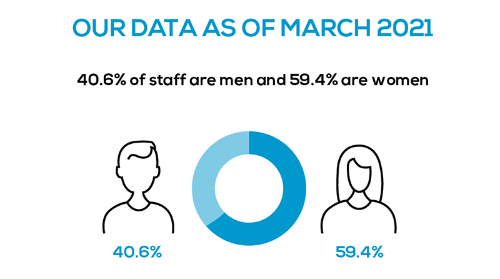
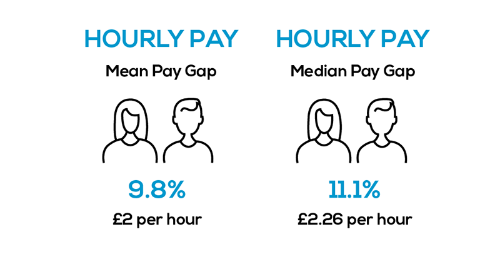
As of March 2021, 40.6% of our staff were men, and 59.4% were women. The mean average gender pay gap at Bath Spa University is 9.8%, equivalent to £2 per hour. The median gender pay gap is 11.1%, or £2.26 per hour. In 2020, these figures were 11.2% and 18.6% respectively, showing a further narrowing of the gender pay gaps. We are very pleased with this continued downward trend, which is shown later in the report.
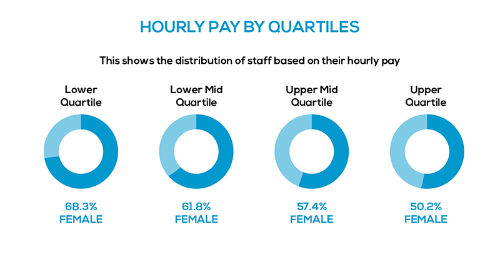
Pay by quartiles shows the distribution of staff based on their hourly pay. We can see from this that our Gender Pay Gap is largely due to higher proportions of women in lower paid roles, especially in the lower quartile, in which there are twice as many women as men. One positive change from previous years is in the upper quartile group, which is now over 50% women, compared to 48% last year.
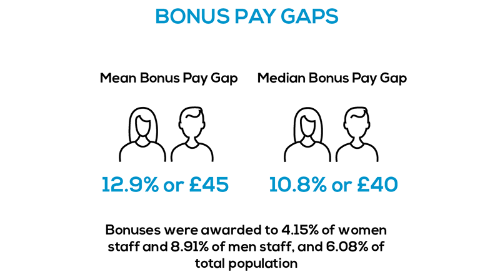
The mean bonus pay gap this year was 12.9%, and the median pay gap 10.8%. Bonus payments were made in 2020 to recognise Estates and Facilities staff that continued to work on campus during the first lockdown as a result of the pandemic. The same value per day was paid to both men and women. Bonus payments were made to 4.2% of women in the workforce, to 8.9% of men in the workforce, and 6.1% of the total workforce.
What does it mean?
The Gender Pay Gap Report is a measure of the difference in pay between the average hourly earnings of male and female staff. The mean is calculated by summing the hourly rates of each employee, then dividing by the number of employees. The median is the middle value when all hourly rates are ranked from smallest to largest.
In our case, pay gaps are mostly due to a higher proportion of women occupying more junior roles within the University, as well as the large number of women employed as casual staff, who are mainly Bath Spa University students. The large number of women casual workers is representative of our student population.
If this last group were excluded from the calculations above, the mean average gender pay gap at Bath Spa would be 7.4% and the median would be 8.5%. However, we are proud to employ our students and offer them development opportunities, and so will continue to do so despite the impact on our gender pay gap figures.
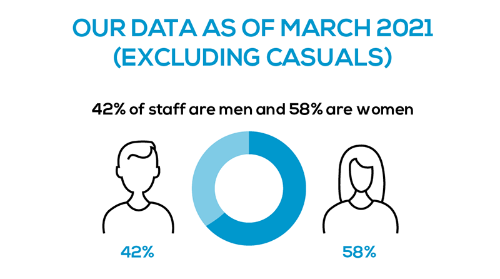
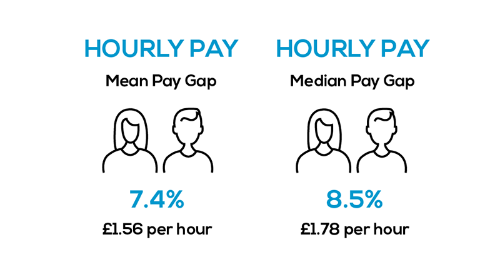
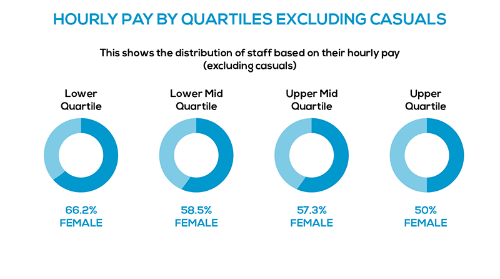
Reducing our Gender Pay Gap
The current gender pay gap at Bath Spa is disappointing, but comparisons to previous year’s data show that both the mean and median pay gaps continue to reduce. This year, we have seen a significant drop of 7.5% in our median pay gap, which is very encouraging. We, as a community, must be committed to working together in addressing the gender pay gap and ensure that we continue to reduce our gender pay gaps in future years.
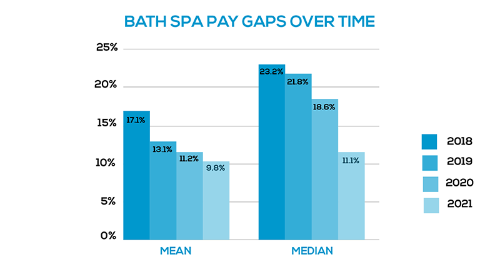
To date, we have introduced a number of measures that aim to reduce the gender pay gap at Bath Spa further, including:
- A strategic restructure of EDSG as an oversight committee, which continues to monitor progress against Equality Objectives and action plan
- Development of Equality Objectives and action plan that focus on mitigating against bias in the staff recruitment process, support for staff equality network development, and continuing to develop an inclusive Bath Spa culture
- Begun HR project to embed BSU cultural values of Inclusion, Collaboration, Sustainability, and Respect into recruitment processes
- Diversity and Unconscious Bias training
- Monitoring of staff experience and wellbeing through regular Staff Surveys
- Continued development of the Women’s Staff Network
- Carried out an Equal Pay review and brought recommendations to reduce equal pay gaps to Senior Leadership team
- Planned a month long programme of events for International Women’s Day that focus on staff development, in collaboration with University of Bath and partners across the South West
- Continued development and delivery of sexual violence framework
- Continued to support the Disabled Staff Network, LGBT+ Staff Network, Global Inclusivity (BAME) Staff Network, recognising the importance of intersectionality and the fact that pay gaps may be exacerbated for staff who are also in these groups.
The gender pay information provided in this report includes our statutory data as a public organisation with more than 250 employees for 31 March 2021. It is also published on the government website.
Our data as of March 2020
As of March 2020, 41.1% of our staff are men, and 58.9% are women. The mean average gender pay gap at Bath Spa University is 11.2%, equivalent to £2.28 per hour. The median gender pay gap is 18.6%, or £4.00 per hour. In 2019, these figures were 13.1% and 21.8% respectively.
Pay by quartiles shows the distribution of staff based on their hourly pay. We can see from this that our Gender Pay Gap is largely due to higher proportions of female staff in lower paid roles.
Our mean and median bonus pay gaps this year were both -100%. This is because one bonus payment was made for exceptional work to a female, non-senior staff member during the reporting period. This means that bonus payments were made to 0.14% of our female workforce and 0% of our male workforce.
What does it mean?
The Gender Pay Gap Report is a measure of the difference in pay between the average hourly earnings of male and female staff. The mean is calculated by summing the hourly rates of each employee, then dividing by the number of employees. The median is the middle value when all hourly rates are ranked from smallest to largest.
In our case, this pay gap is mostly due to a higher proportion of female staff occupying more junior roles within the University, as well as the large number of female casual staff we employ, who are mainly Bath Spa University students. The large number of female casual workers is representative of our student population.
If this last group were excluded from the calculations above, the mean average gender pay gap at Bath Spa would be 8.2% and the median would be 8.8%. However, we are proud to employ our students and offer them development opportunities, and so will continue to do so despite the impact on our gender pay gap figures.
Reducing our Gender Pay Gap
The current gender pay gap at Bath Spa is disappointing, but comparisons to previous year’s data show that both the mean and median pay gaps are reducing. We, as a community, must be committed to working together in addressing the gender pay gap and ensure that we continue to reduce our gender pay gaps in future years.
To date, we have introduced a number of measures that aim to reduce the gender pay gap at Bath Spa, including relaunching the Women’s Network, Diversity and Unconscious Bias training, and our Developing Leaders Programme.
We have also:
- Continued to review how we perform against our Equality Objectives. We are currently in the process of writing our Equality Objectives 2021-25 which will continue to focus on equality in recruitment, development, and support of staff, as well as continuing to develop Bath Spa’s inclusive culture.
- Continued to monitor overall staff experience through our regular Staff Surveys.
- Engaged with a range of staff in the development of our People and Culture strategy, which has included the development of our four values: Inclusivity, Collaboration, Sustainability, and Respect
- Started a review of our recruitment process and begun blind shortlisting for professional services staff, in an attempt to improve equality in our hiring practises.
- Continued to use positive action statements in recruitment advertisements.
- Continued our commitment to publishing internal Equal Pay Reviews every two years.
- Continued to pursue transparency and communication of gender pay gap information.
- Begun planning a consultation process to build a staff support framework around sexual violence, harrassment, and supporting students who are victim-survivors of sexual violence.
- Continued to support the Disabled Staff Network, LGBT+ Staff Network, Global Inclusivity (BAME) Staff Network, and are currently in planning stages for the launch of a Parents and Carers Network, recognising the importance of intersectionality and the fact that pay gaps may exacerbated for staff who are also in these groups.
- Carried out equality impact assessments in relation to gender and other protected characteristics when writing our submission for REF 2021, taking positive action where necessary in the selection outputs for submission.
The gender pay information provided in this report includes our statutory data as a public organisation with more than 250 employees for 31 March 2020. It is also published on the government website.
Our data as of March 2019
The mean average gender pay gap at Bath Spa University is 13.1% and the median average is 21.8%. In 2019 these figures were 17.1% and 23.2% respectively.
Our mean and median bonus pay gaps this year are both 0%. This is because bonus payments of equal value were made to two people (one female and one male) during the reporting period. This was the result of exceptional work. This means that bonus payments were made to 0.12% of our female workforce and 0.19% of our male workforce.
What does it mean?
The Gender Pay Gap Report is a measure of the difference in pay between the average hourly earnings of male and female staff.
In our case, this pay gap is mostly due to a higher proportion of female staff occupying more junior roles within the University, as well as the large number of female casual staff we employ, who are mainly Bath Spa University students. The large number of female casual workers is representative of our student population.
If this last group were excluded from the calculations above, the mean average gender pay gap at Bath Spa would be 9.2% and the median would be 11.1%. However, we are proud to employ our students and offer them development opportunities, and so will continue to do so despite the impact on our gender pay gap figures.
Reducing our Gender Pay Gap
The current gender pay gap and Bath Spa is disappointing, but comparisons to our 2018 and 2019 data show that both the mean and median pay gaps are reducing. We, as a community, must be committed to working together in addressing this vital moral and social challenge and ensure that we continue to reduce our gender pay gaps in future years.
Encouragingly, the number of our female staff in professorial roles has continued to increase, and now represents over 50% of our professorial headcount. This means we've successfully hit one of our Equality Objectives before its 2021 deadline.
To date, we have introduced a number of measures that aim to reduce the gender pay gap at Bath Spa, including the Women’s Network, Diversity and Unconscious Bias training, and our Developing Leaders Programme.
We have also:
- Continued to review how we perform against our Equality Objectives
- Continued to monitor and address both the strengths and weaknesses of our university culture through our regular Staff Surveys
- Started a review of our recruitment process, in an attempt to improve equality in our hiring practices
- Continued to use and monitor positive action statements in recruitment advertisements
- Continued our commitment to publishing internal Equal Pay Reviews
- Continued to pursue transparency and communication of gender pay gap information.
Our data as of March 2018
Analysis of 17/18 pay data shows that there has been a reduction in the percentage of males being paid more than females across the University; the overall pay gap has decreased from 12.04% to 11.1%. Analysis shows that the reason why overall men are paid more than women is the gender distribution of the University, in which male staff tend to be more highly represented within senior roles and female staff tend to be more highly represented in lower graded roles.
Whilst it is significant to note that analysis of the individual pay grades showed that all pay gaps present were within the 5% threshold, in general, women are more likely to start at the bottom spinal point of their respective grades than their male counterparts, and are more likely to leave BSU with a shorter length of service. These two issues combine to create a situation where fewer women are reaching the top spinal points of their grade, thus creating gender pay gaps within individual grades.
These issues are broader equality issues around gender representation culturally and the University will continue to consult with staff and consider initiatives to increase gender representation across all levels as published in the University Equality Objectives.
Reducing our gender pay gap
The University has made steps to reduce the pay gap by doing the following:
- Conducting the annual equality and diversity report to see any areas of inequality in senior roles between males and females.
- To continue to consult with staff on the findings of this report, and to consider initiatives to increase gender representation across all senior grades as published in our Equality objectives.
- Producing the annual HR metrics report to see if there are any discrepancies between males and females being promoted or moving internally within the University. To also look at the number of males and female new starters and leavers within each grade.
- Committing to secure Athena Swan (AS) bronze level accreditation by 2020
- Develop female staff at leadership level Bands 7 and 8 and in other areas where specific under-representation is evidenced by launching a women’s leadership network open to all self-identifying female staff and through the continued use our Developing Leaders Programme.
The University continues to be committed to equality of opportunity for all staff and part of this commitment is equality in the application of its pay and grading structure to ensure equal pay for work of equal value and will undertake a further Equal Pay Review for 2021.
Our data as of March 2017
The mean average gender pay gap at Bath Spa University is 17.1% and the median average is 23.2%.
The median female bonus is £1,500 and the median male bonus is £5,750, which has led to the gender pay gap quoted. These figures are based on a total of 18 people (12 female and 6 male) receiving a bonus as a result of exceptional work. This constitutes only just over 1% of staff, therefore the statistics around bonus payments are not representative of the whole University.
Please note that these figures relate to the 2017/18 year. We have looked ahead to our gender pay gap report for 2020 which will include figures from 2018/19 and have found that both the mean and median bonus pay gaps will be 0%.
What does it mean?
The “Mean” is calculated by summing the hourly rates of each employee, then dividing by the number of employees. The “Median” is the middle value when the hourly rates are ranked from smallest to largest.
The Gender Pay Gap Report is a measure of the difference in pay between the average hourly earnings of male and female staff.
In our case, this pay gap is mostly due to a higher proportion of female staff occupying more junior roles within the University, as well as the large number of female casual staff we employ, who are mainly Bath Spa University students. The large number of female casual workers is representative of our student population.
If this last group were excluded from the calculations above, the mean average gender pay gap at Bath Spa would be 10.9% and the median would be 8.5%. However, we are proud to employ our students and offer them development opportunities, and so will continue to do so despite the impact on our gender pay gap figures.
Gender Pay Gap and Equal Pay
Equality is key to the success story of Bath Spa University. In fact, we produced our own reports about equal pay, the Equal Pay Review, long before the 2017 legislation that required the publication of gender pay gap calculations came into place.
It is important to understand that these two reports and the statistics shown in them are different. The Equal Pay Review looks at basic pay of salaried staff, whereas the Gender Pay Gap looks at all relevant staff (including associate lecturers and casual workers) who worked in March of the given year, and takes issues such as salary sacrifice into account.
Our Equal Pay Review compares the pay of male and female employees who are doing work of equal value and checks to see if there are any differences or inequalities. In doing so, we can monitor the effectiveness of our pay framework and job evaluation processes which were put in place as part of our commitment to ensure equal pay of equal value.
Reducing our gender pay gap
The current gender pay gap at Bath Spa is disappointing, but reducing the gap is achievable. We, as a community, must work together in addressing this vital moral and social challenge and things are moving in the right direction.
Encouragingly, an increasing number of our female staff are now in professorial roles which is higher than the sector average. And, if we look ahead to our gender pay gap report for 2020, we know that both the mean and median bonus pay gaps will be 0%.
To date, we've introduced a number of measures that aim to reduce the gender pay gap at Bath Spa, including Diversity and Unconscious Bias training and our Developing Leaders Programme.
We have also:
- Continued to review how we perform against our Equality Objectives
- Continued to monitor and address the strengths and weaknesses of our culture through regular staff surveys
- Reviewd the use of positive action statements in recruitment advertisements
- Planned a further Equal Pay review for later this year
- Continued to pursue transparency and communication of gender pay gap information
Our data as of March 2016
The mean average gender pay gap at Bath Spa is 17.2% and the median average is 23.7%.
"Mean" is the figure that's determined by adding all the numbers and dividing by the number of numbers. The "median" is the middle value in the list of numbers, when the numbers are listed in numerical order from smallest to largest.
The current gender pay gap at Bath Spa is disappointing, but reducing the gap is achievable. We, as a community, must work together in addressing this vital moral and social challenge.
The Gender Pay Gap Report is a measure of the difference in pay between the average hourly earnings of male and female staff.
In our case, this pay gap is mostly due to a higher proportion of female staff occupying more junior roles within the University, as well as the large number of female casual staff we employ, who are mainly Bath Spa University students.
If this last group were excluded from the calculations above, the mean average gender pay gap at Bath Spa would be 12.1% and the median would be 8.5%. However, we are proud to employ our students and offer them development opportunities, and so will continue to do so despite the impact on our gender pay gap figures.
The median female bonus is £1,250 and the median male bonus is £1,500, which has led to the gender pay gap quoted. These figures are based on a total of 11 people (eight female and three male) receiving a bonus as a result of exceptional work. This constitutes less than 0.9% of staff, therefore the statistics around bonus payments are not representative of the whole University.
Gender Pay Gap and Equal Pay
Equality is key to the success story of Bath Spa University. In fact, we produced our own reports about equal pay, the Equal Pay Review, long before the 2017 legislation that required the publication of gender pay gap calculations came into place.
It is important to understand that these two reports and the statistics shown in them are different. The Equal Pay Review looks at basic pay of salaried staff as a snapshot as of 31 July that year, whereas the Gender Pay Gap looks at all staff (including associate lecturers and casual workers) who worked in March of the given year, and takes issues such as salary sacrifice into account.
Our Equal Pay Review compares the pay of male and female employees who are doing equal work and checks to see if there are any differences or inequalities. In doing so, we can monitor the effectiveness of our pay framework and job evaluation processes which were put in place as part of our commitment to ensure equal pay of equal value.
Reducing our gender pay gap
We've introduced a number of measures that aim to reduce the gender pay gap at Bath Spa, including Diversity and Unconscious Bias training and our Developing Leaders Programme.
We have also:
- Revised the University's Equality Objectives for 2018 to highlight recruitment, inclusion and retainment of women and BME staff and students
- Actively supported our emale staff in their professonal development via in-house initiatives such as workshops on Imposter Syndrome and Leadership
- Continued to monitor and address the strengths and weaknesses of our culture through regular staff surveys
- Reviewed the use of positive action statements in recruitment advertisements
- Committed to completing the institutional application to the Athena SWAN Charter and external accreditation, which provides dedicated support and development for female staff
- Established the Women's Leadership Network at Bath Spa
- Scheduled a further Equal Pay review for 2017/18
- Continued to pursue transparency and communication of gender pay gao information